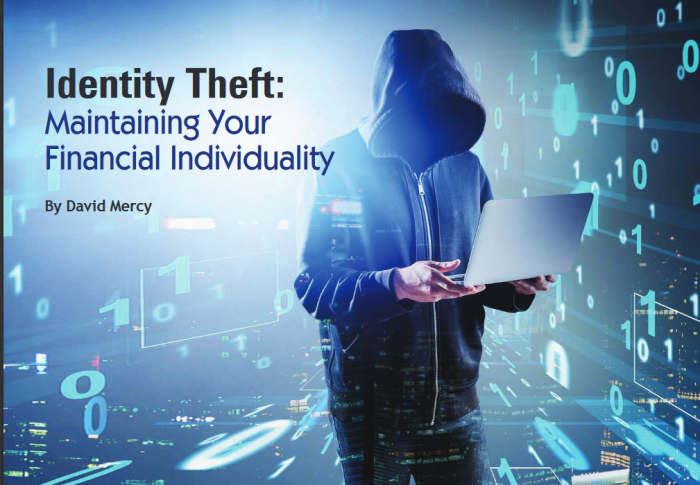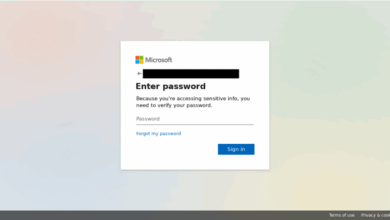Combating ID Theft on the Internet
Combating ID theft on the internet is crucial in today’s digital age. It involves understanding the various methods used by criminals to steal your personal information, from phishing scams to malware infections. This comprehensive guide will explore the vulnerabilities, prevention strategies, reporting procedures, and technological solutions to protect yourself from becoming a victim of identity theft online.
We’ll delve into the different types of online identity theft, examining the tactics employed by cybercriminals and the personal information they target. This exploration includes a comparative analysis of common identity theft schemes, highlighting the key differences between phishing, malware attacks, and social engineering. We’ll also discuss the crucial role of strong passwords, multi-factor authentication, and secure browsing practices in preventing these crimes.
Defining Internet Identity Theft: Combating Id Theft On The Internet
Internet identity theft, a pervasive threat in the digital age, is the fraudulent acquisition and use of another person’s online identity for personal or financial gain. It differs from other online scams like phishing or malware attacks in that the core objective is to assume the victim’s online persona, exploiting their digital footprint for illicit purposes. This can range from opening fraudulent accounts to making unauthorized purchases.Criminals employ various sophisticated methods to steal online identities, often targeting vulnerable individuals or exploiting weaknesses in online security systems.
This includes techniques that leverage psychological manipulation and technical vulnerabilities to gain access to sensitive information. The stolen information is then used to commit further crimes, often leaving the victim with significant financial and reputational damage.
Methods of Online Identity Theft
Understanding the methods employed by online identity thieves is crucial for proactive protection. These techniques can be broadly categorized into several key methods.
- Phishing: This deceptive practice involves tricking individuals into revealing personal information through fraudulent emails, websites, or messages. Phishing emails often mimic legitimate communications from trusted institutions, such as banks or social media platforms, to instill a sense of urgency or trust, leading victims to disclose sensitive data. The deceptive nature of phishing often relies on creating a sense of urgency or urgency in the email.
- Malware: Malicious software, or malware, can infiltrate systems to steal data. This includes spyware, keyloggers, and ransomware. Spyware monitors online activity and captures keystrokes, while keyloggers record every keystroke made on a computer. Ransomware encrypts files and demands payment for their release. Malware often hides within seemingly harmless downloads or attachments.
- Social Engineering: This involves manipulating individuals into divulging sensitive information through psychological tactics. Social engineers often create a sense of trust and urgency, employing emotional manipulation to trick individuals into revealing their credentials or sensitive information. This often relies on trust and exploiting vulnerabilities.
Types of Targeted Personal Information
Identity thieves target various types of personal information, exploiting these details to impersonate the victim and access their accounts.
- Login credentials (usernames and passwords): These are the fundamental access points to online accounts, providing thieves with entry into various digital domains. Stolen login credentials can be used to access email accounts, bank accounts, social media profiles, and more.
- Financial information (credit card numbers, bank account details): Financial information is a primary target for identity theft, enabling criminals to make unauthorized purchases or withdraw funds from victims’ accounts.
- Personal identification documents (social security numbers, driver’s license numbers): These documents are essential for verifying identity, making them highly valuable to identity thieves.
- Address details (home and work addresses): These details can be used for mail theft or to receive fraudulent packages.
Comparison of Online Identity Theft Schemes
The table below provides a concise comparison of common online identity theft schemes, highlighting their descriptions, tactics, and examples.
| Scheme Type | Description | Common Tactics | Example |
|---|---|---|---|
| Phishing | A fraudulent attempt to obtain sensitive information, such as usernames, passwords, and credit card details, by disguising oneself as a trustworthy entity in electronic communication. | Creating fake websites that mimic legitimate websites, sending deceptive emails or messages, using social engineering tactics. | A user receives an email seemingly from their bank, prompting them to update their account information on a fake website. |
| Malware | Malicious software designed to infiltrate and damage a computer system, often used to steal sensitive information. | Disguising malware as legitimate software, exploiting security vulnerabilities, using social engineering to spread malware. | A user downloads a seemingly harmless file that contains spyware, which secretly collects their browsing history and login credentials. |
Vulnerabilities and Risks
Navigating the digital world comes with inherent risks, and understanding these vulnerabilities is crucial to protecting your online identity. Cybercriminals are constantly developing new tactics to exploit weaknesses, making it essential for individuals to be proactive in safeguarding their personal information. This section will delve into the key vulnerabilities that expose individuals to internet identity theft, outlining the risks associated with various online activities and the severe consequences of falling victim.
Key Vulnerabilities
Individuals are susceptible to internet identity theft due to a combination of factors. These include a lack of awareness about online security practices, the use of weak or easily guessed passwords, and the tendency to reuse passwords across multiple accounts. Social engineering tactics, where attackers manipulate individuals into divulging sensitive information, also play a significant role. Failure to regularly update software and operating systems leaves systems vulnerable to known exploits, while insufficient security measures on personal devices further compounds the risk.
Risks of Public Wi-Fi
Public Wi-Fi networks are notorious for their security vulnerabilities. These networks often lack robust encryption, making it easier for malicious actors to intercept data transmitted over the connection. This can include login credentials, financial information, and other sensitive data. Users connecting to unsecure public Wi-Fi are at a heightened risk of having their accounts compromised, leading to identity theft and financial losses.
Risks of Unsecured Websites, Combating id theft on the internet
Visiting unsecure websites, particularly those without HTTPS encryption, exposes individuals to significant risks. These websites are vulnerable to man-in-the-middle attacks, where attackers intercept communications between the user and the website. This allows them to steal sensitive data, such as credit card numbers and login credentials. The lack of encryption makes it challenging to ascertain the authenticity of the website, increasing the likelihood of encountering phishing attempts and malware.
Consequences of Identity Theft
The consequences of falling victim to internet identity theft can be far-reaching and devastating. Financial losses are a primary concern, encompassing fraudulent charges, unauthorized access to bank accounts, and credit card misuse. Reputational damage can be equally severe, impacting an individual’s professional and personal life. The emotional distress caused by identity theft can be substantial, leading to anxiety, stress, and a sense of violation.
Common Vulnerable Scenarios
| Scenario | Vulnerability | Risk |
|---|---|---|
| Using public Wi-Fi | Lack of encryption, potential for eavesdropping. | Compromised login credentials, stolen financial information. |
| Using weak passwords | Easy to guess or crack passwords. | Unauthorized access to accounts, data breaches. |
| Clicking on suspicious links | Phishing attempts, malware infections. | Compromised accounts, data theft, identity theft. |
| Not updating software | Exploitable vulnerabilities. | System compromise, data breaches, malware infections. |
| Reusing passwords | If one account is compromised, all accounts are at risk. | Multiple accounts compromised, significant financial and personal loss. |
Prevention Strategies
Protecting your online identity requires a proactive approach. Cybercriminals constantly adapt their tactics, making vigilance crucial. This section Artikels key strategies to safeguard your digital footprint and mitigate the risk of identity theft.Proactive measures are vital in the ongoing battle against online fraud. By understanding the common tactics and implementing the recommended practices, individuals can significantly reduce their vulnerability to identity theft.
Protecting your online identity from theft is crucial. A big part of that is understanding the human element in email security – e mail security the human factor plays a huge role. After all, phishing scams and social engineering tricks often rely on exploiting our trust and carelessness. Ultimately, being vigilant about email practices is a key strategy in combating online identity theft.
A layered approach, combining various security measures, provides the best defense.
Strong Passwords
Creating strong passwords is fundamental to online security. Weak passwords are easily guessed or cracked, exposing accounts to unauthorized access. Strong passwords should be unique for each account and incorporate a mix of uppercase and lowercase letters, numbers, and symbols. Avoid using easily guessable information like birthdates, names, or pet names.
A strong password is a crucial first line of defense against unauthorized access.
Examples of strong passwords: `Pa$$wOrd123!` or `MySecret_Password`.
Multi-Factor Authentication (MFA)
Enabling MFA adds an extra layer of security to your accounts. MFA requires more than just a username and password. It often involves receiving a code via SMS or email, or using an authenticator app. This significantly reduces the risk of unauthorized access, even if a password is compromised.
Multi-factor authentication adds an essential layer of security by requiring multiple verification methods.
Activating MFA is a highly recommended practice for all online accounts.
Protecting your online identity from theft is crucial. Recent news about Intel CEO Barrett’s vision for the tech industry in China, as detailed in intel ceo barrett sees it transforming china , highlights the evolving landscape of cybersecurity. Ultimately, these advancements need to be matched with stronger protections against online identity theft, ensuring a secure digital future for everyone.
Regular Software Updates
Keeping software updated is critical. Updates often include security patches that address vulnerabilities exploited by hackers. Failing to update software leaves your devices and accounts exposed to potential threats. Configure your devices to automatically download and install updates when available.
Protecting your online identity from theft is crucial. Think about how easy it is to fall prey to scams, especially when you’re dealing with online gaming communities. This is made even more pertinent when considering how Aol wants gamers to add AIM, aol wants gamers to add aim , and the potential for increased online interaction. The more connected we get, the more vulnerable we become, so vigilance remains paramount in combating online identity theft.
Regular software updates are essential to address vulnerabilities and maintain a strong security posture.
Checking for and installing updates regularly is a crucial component of protecting your digital assets.
Recognizing and Avoiding Phishing Attempts
Phishing attacks attempt to trick you into revealing sensitive information, such as passwords or credit card details. Phishing emails and messages often appear legitimate, but scrutinize them carefully. Look for suspicious grammar, unusual requests, or unfamiliar sender addresses. Never click on links or open attachments from unknown senders.
Be cautious of unsolicited emails or messages, and verify the legitimacy of any requests for personal information.
Verify the source of any communication requesting sensitive information before responding.
Protecting Yourself from Online Scams
Online scams can take many forms, from fake shopping websites to fraudulent investment opportunities. Always verify the legitimacy of websites and businesses before sharing personal information or making transactions. Conduct thorough research on businesses or individuals before engaging in any online dealings.
Always verify the legitimacy of online businesses and individuals before engaging in any online transactions.
Use reliable online resources to assess the reputation and authenticity of online sellers or services.
Online Account Management Best Practices
Managing your online accounts effectively is crucial for protecting your identity. Regularly review your account activity for any suspicious transactions or login attempts. Use strong passwords and enable MFA for each account. Consider using a password manager to securely store and manage your passwords.
Managing your online accounts effectively is a proactive approach to protecting your digital identity.
Regularly reviewing your account activity is essential for identifying and preventing potential security breaches.
Reporting and Recovery

Navigating the aftermath of internet identity theft can feel overwhelming. Knowing the proper procedures for reporting and recovery is crucial for mitigating damage and regaining control of your online presence. This section Artikels the steps you need to take to protect yourself and your financial well-being.Understanding the process empowers you to act swiftly and effectively when facing this type of crime.
From contacting the appropriate authorities to monitoring your credit reports, a proactive approach is essential in minimizing the long-term consequences of identity theft.
Reporting Suspected Internet Identity Theft
Reporting suspected internet identity theft to the correct authorities is vital for initiating the recovery process. A clear understanding of the reporting channels ensures that your complaint is handled efficiently. Different agencies have jurisdiction over different aspects of online fraud. You should report to the relevant agencies based on the type of theft and the actions taken.
Steps to Take After Becoming a Victim
Taking proactive steps after becoming a victim of internet identity theft is essential to minimize the damage and recover your financial standing. The process involves multiple crucial steps, including contacting credit bureaus and monitoring your credit reports.
- Contacting Credit Bureaus: Immediately notify all three major credit bureaus (Equifax, Experian, and TransUnion) about the suspected or confirmed identity theft. This action is crucial for preventing further fraudulent activity on your credit accounts.
- Monitoring Credit Reports: Actively monitor your credit reports regularly. This vigilance allows you to identify any unauthorized activity promptly, enabling quicker intervention.
- Filing a Police Report: Reporting the incident to your local law enforcement agency is a vital step in the process. A police report documents the incident and can be used as evidence in future legal proceedings.
Resources for Victims of Internet Identity Theft
Several resources are available to victims of internet identity theft, offering support and assistance throughout the recovery process. These resources can provide valuable guidance and support.
- Support Groups: Support groups dedicated to identity theft victims provide a safe space to share experiences and receive encouragement. These groups offer a sense of community and understanding among individuals facing similar challenges.
- Legal Assistance: Legal professionals specializing in identity theft can provide guidance and support in navigating the legal processes. They can assist with filing claims, negotiating with creditors, and representing you in court, if necessary.
- Government Agencies: Federal Trade Commission (FTC) and other government agencies offer valuable resources and information on identity theft prevention and recovery. These agencies can guide you through the process and provide support.
Reporting Procedure
The following table Artikels the steps involved in reporting identity theft. This structured approach simplifies the process and ensures all critical steps are taken.
| Step | Action | Contact |
|---|---|---|
| 1 | Immediately report to all three major credit bureaus (Equifax, Experian, and TransUnion). | Credit Bureaus’ websites or toll-free numbers. |
| 2 | File a police report with your local law enforcement agency. | Local Police Department |
| 3 | Place fraud alerts on your credit reports. | Credit Bureaus |
| 4 | Contact financial institutions (banks, credit card companies, etc.). | Financial Institutions |
| 5 | Monitor your accounts for suspicious activity. | Yourself and financial institutions |
Technological Solutions
Staying ahead of evolving cyber threats requires a robust arsenal of technological tools. This section delves into emerging technologies and software designed to combat internet identity theft, highlighting the crucial role of artificial intelligence and machine learning in fraud detection. It also examines how secure browsing tools and extensions can help prevent identity theft, and compares different security software solutions.The fight against internet identity theft is a continuous arms race.
Cybercriminals are constantly developing new tactics, demanding that individuals and organizations adapt their defenses. Technological solutions play a critical role in this dynamic struggle.
Artificial Intelligence and Machine Learning in Fraud Detection
Artificial intelligence (AI) and machine learning (ML) algorithms are increasingly vital for detecting fraudulent activities. These technologies can analyze vast amounts of data, identifying patterns and anomalies that human analysts might miss. ML algorithms are trained on historical data of fraudulent transactions, enabling them to learn and adapt to new types of attacks. This allows for quicker detection and response to potentially harmful activities.
For example, AI-powered systems can flag unusual login attempts, suspicious financial transactions, or potentially compromised accounts, alerting users and organizations to potential threats.
Secure Browsing Tools and Extensions
Secure browsing tools and extensions provide a layer of protection while online. These tools often incorporate features such as automatic password management, phishing detection, and secure VPN connections. They enhance user security by protecting against various threats that lurk on the internet. Strong password management, crucial for safeguarding accounts, is often a feature. By generating strong, unique passwords and securely storing them, these extensions help prevent credential compromise.
Phishing detection tools proactively identify fraudulent websites and emails, preventing users from falling prey to deceptive schemes.
Comparison of Security Software Solutions
Choosing the right security software is crucial for comprehensive protection. Different solutions offer varying features and functionalities, and comparing them is essential to find the best fit. Factors to consider include the range of threats addressed, the user interface, the level of technical expertise required, and the level of support provided. A table comparing different security software solutions, including antivirus software, anti-malware programs, and identity theft protection services, will help in the decision-making process.
| Software Category | Example Solution 1 | Example Solution 2 | Key Features |
|---|---|---|---|
| Antivirus | Norton AntiVirus | Bitdefender Antivirus | Detects and removes viruses, malware, and other malicious threats. Offers real-time protection and scheduled scans. |
| Anti-malware | Malwarebytes | Sophos Anti-threat Protection | Specialized in detecting and eliminating malware. Often includes real-time monitoring and on-demand scans. |
| Identity Theft Protection | LifeLock | IdentityForce | Monitors financial accounts, credit reports, and other personal information for suspicious activity. Offers alerts and support in case of a breach. |
Different security software solutions provide varying levels of protection. Users should carefully evaluate their needs and choose solutions that effectively address their specific concerns.
Legal and Regulatory Frameworks

Protecting personal information online is paramount, and robust legal frameworks are crucial in deterring and addressing internet identity theft. These frameworks act as a shield, outlining responsibilities and penalties for those who engage in fraudulent activities, while providing recourse for victims. Governments play a critical role in establishing and enforcing these rules, working alongside industry stakeholders to foster a safer online environment.The legal landscape surrounding internet identity theft is constantly evolving, mirroring the dynamic nature of online fraud.
Laws and regulations must adapt to emerging threats and technologies, ensuring that individuals and businesses are adequately protected from the ever-increasing sophistication of cybercriminals. This necessitates a proactive approach by governments and regulatory bodies to stay ahead of the curve.
Role of Laws and Regulations
Laws and regulations play a vital role in mitigating internet identity theft by establishing legal boundaries for online conduct. These regulations typically address issues such as data privacy, consumer protection, and criminal offenses. Laws regarding identity theft often include provisions for penalties, which can include fines and imprisonment.
Importance of Government Agencies
Government agencies are instrumental in combating internet identity theft. They play a key role in investigating cybercrimes, coordinating efforts across various jurisdictions, and developing public awareness campaigns. Specific agencies, like the Federal Trade Commission (FTC) in the United States, are dedicated to protecting consumers from fraud and identity theft. Their investigations and enforcement actions help deter future criminal activity.
Legal Recourse for Victims
Victims of internet identity theft have legal recourse, enabling them to seek compensation and redress. Depending on the jurisdiction, this may involve filing a civil lawsuit, reporting the crime to law enforcement, or pursuing administrative remedies. These options can vary based on the specific circumstances and laws governing identity theft in the region. For example, in many jurisdictions, victims can report fraud to their financial institutions and receive assistance in recovering lost funds.
Regulatory Bodies and Online Fraud
Regulatory bodies, such as the Federal Trade Commission (FTC) in the United States, address online fraud through various means. These include issuing guidelines and regulations for businesses, conducting investigations into fraudulent activities, and educating consumers on how to protect themselves. These agencies also work to ensure compliance with established regulations by holding companies accountable for their data security practices.
Additionally, regulatory bodies often collaborate with industry stakeholders to develop and implement improved security measures. For example, the FTC may work with credit bureaus to enhance procedures for identity verification and dispute resolution.
Final Conclusion
In conclusion, combating online identity theft requires a multi-faceted approach. Individuals must be proactive in safeguarding their online identities by employing strong security measures and practicing safe online habits. Reporting suspected identity theft promptly and understanding available recovery options are equally important. By combining individual vigilance with technological advancements and robust legal frameworks, we can collectively work towards a safer online environment for everyone.







